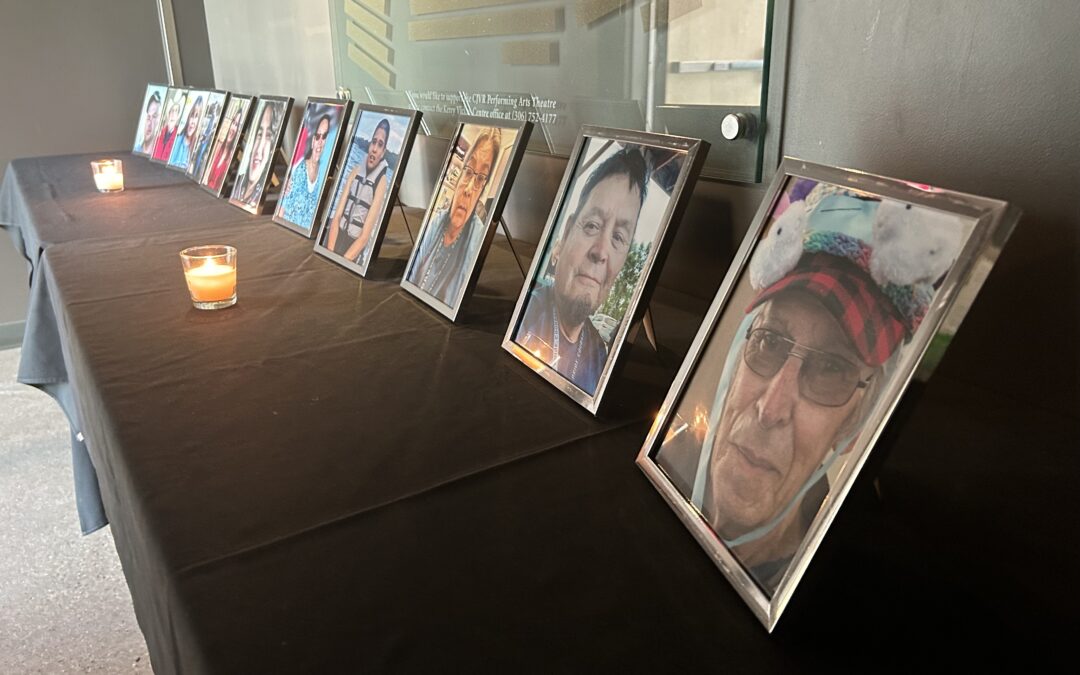WARNING: Distressing content.
The Coroner’s Inquest into the mass stabbing on James Smith Cree Nation and in the Village of Weldon continued hearing testimony Tuesday.
Staff Sgt. Robin Zentner, who supervised the investigation of the stabbings for the Saskatchewan RCMP continued with his testimony, which laid out the events leading up to the mass stabbing and the stabbings themselves. A number of the details had previously been revealed by the RCMP as part of the preliminary timeline of events in April of 2023.
During his testimony Zentner provided additional information about the crime scenes which included photographs. The inquest as well got to hear several 911 calls made relating to the incident and was shown some of the dash camera footage of RCMP officers traveling to James Smith the morning of.
The photographs shown included an overhead shot of the area where Damien Sanderson’s body was found. In the photo Damien’s body could clearly be seen. In the days after the mass stabbings police had originally named both the brothers as suspects before announcing that Damien had been found dead and was considered to be a victim.
Zentner explained due to the large number of crime scenes some, like the one where Damien’s bloody shirt was found, were not processed right away. On cross examination from the family of Bonnie Burns, Zentner said the RCMP also try to avoid processing scenes in the dark where possible evidence could be missed or damaged.
Once RCMP began processing the scene they found blood which helped lead them to where Damien died.
“Those crime scene specialists located a blood trail,” said Zentner.
The Staff Sgt. added the terrain where the body was found also made it challenging to find the body initially, as the vegetation in the area made it hard to see the body.
The inquest as well got some insight into the reasons why some people may have been targeted by Myles Sanderson. Zentner testified during their investigation police found messages showing that the victim at the first home the two travelled to had asked Damien to see if Myles would front him drugs, to which Damien replied his brother was looking for money.
“Damien had replied his bro needed cash,” said Zentner.
Throughout his testimony, Zentner showed a number of messages found by investigators, many of which involved Myles communicating with a number of people including victims. A number of the messages mentioned illicit drugs.
“There’s definitely drug conversations and drug talk,” he said.
Another underlying theme in text messages found by investigators was mention of gangs and gang affiliations. There was also a number of times the word mission was used. Zentner said the word is used in the gang world and can involve people being given a task to do by somewhat who is higher up in the gang than them. The text messages as well showed that Myles and Damien were targeting people in the community who were known to be affiliated with the Terror Squad gang.
However, Zentner said there is nothing indicating that anyone else besides the two brothers were involved.
“There’s no information that we have that anyone directed them,” he said.
Zentner as well said the police investigation found that no one helped Myles in carrying out the attacks and during cross examination by the lawyer representing James Smith Cree Nation, Zentner said they found no evidence Myles was an active gang member.
The inquest as well heard about how Myles targeted members of his own family during the attack. Zentner said when he traveled to the home of his in laws, he attacked his father in law Earl Burns Sr. During this attack one of Myles’ children, who was was in the basement of the house, told police he heard his father threaten his grandfather and other family members.
“I’m going to kill you and my son,” said Zentner.
Drugs and drug trade a major issue
Daryl Burns, who has worked as an addictions counsellor for James Smith Cree Nation, lost his sister Lydia Gloria Burns to the violence. Speaking to media during a break in the hearings Tuesday, Burns said much of the evidence presented shows drugs are a major issue in the community.
“The majority of the people that died in the massacre were involved in the drug trade,” he said.
Going forward Burns said he hopes to see some of the inquest recommendations speak to the issue of drugs. However, he said the recommendations need to be backed up with some real actions.
“The recommendations are only words, words written on a paper, we need to have the resources and the people to carry out the recommendations,” he said.
Burns said work as well needs to be done to promote healthier living to push back against the lifestyle of drugs, which he said has become normalized.
“So if you could turn that around and make sobriety and healthy living an acceptable part of society, then we’ll be better off,” he said.
Talking Stick is a Saskatchewan-based free anonymous chat platform that connects people seeking emotional support to a trained Indigenous peer advocate 24/7. https://my.talkingstick.app/
